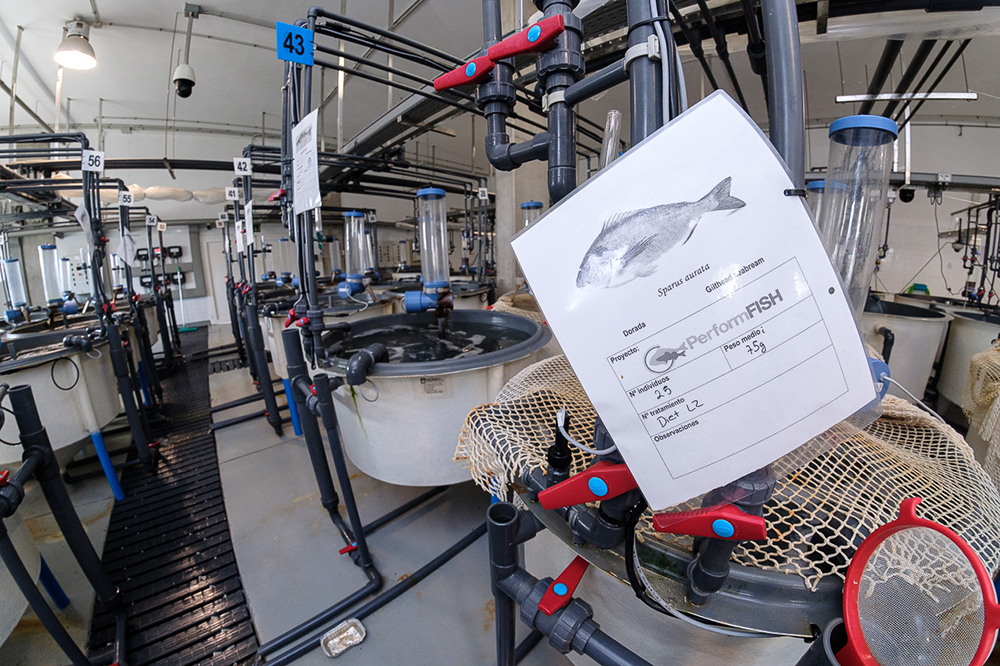The Aquaculture Research Group (GIA) of the University Institute ECOAQUA of the ULPGC presented the results of its studies on the genetic architecture of body malformations in sea bream (Sparus aurata) in the last days of the European research project, which took place throughout the month of May. The results from this project demonstrated that demonstrating that broodstock show poorer spawning quality and a higher rate of offspring with skeletal malformations if their parents already presented a genetic propensity for malformations.
This breakthrough will lead to the development of a practical molecular biology tool for the sea bream aquaculture sector that will have an impact on the optimisation of production yields.
The finding of the Aquaculture Research Group of the University Institute for Research in Sustainable Aquaculture and Marine Ecosystems (ECOAQUA), one of the major advances presented at the fourth annual meeting of the PerformFISH project (Consumer Driven Production: Integrating Innovative Approaches for Competitive and Sustainable Performance across the Mediterranean Aquaculture Value Chain), demonstrates the enormous importance of knowing the family genetic background in the appearance of morphological deformations in offspring.
In collaboration with the Nutrigenomics and Endocrinology of Fish Growth group of the Torre de la Sal Aquaculture Institute (CSIC) and the Canarian company AQUANARIA S.L., the Aquaculture Research Group of the ECOAQUA Institute of the University of Las Palmas de Gran Canaria (ULPGC) has thus managed to identify a total of 317 genes involved in functions related to the regulation of signalling, the transport of substances, metabolic processes and cell evolution, the development of the nervous system and biological adhesion. According to this study, 64 of these genes show a great variety in gene expression or polymorphic expression, among which, eight of them are associated with chromosomal regions (QTL) related to deformities in sea bream.
The breakthrough will lead to the development of a practical molecular biology tool for the sea bream aquaculture sector that will optimise production yields by discarding specimens with a genetic propensity for malformations, thus avoiding the economic problems that arise from these animals.
The ECOAQUA GIA was represented at the fourth annual meeting of the European PerformFISH project by Professor of Biology and Vice-Rector for Research at the ULPGC, Marisol Izquierdo, scientific coordinator of the research group, by Professor Juan Manuel Afonso, director of the GIA, by Professor Daniel Montero, director of the PhD programme in Sustainable Aquaculture and Marine Ecosystems, by Hyun Suk Shin and David Domínguez, postdoctoral researchers, and by Marta Carvalho and Álvaro Lorenzo Felipe, predoctoral researchers.
PerformFISH, which includes IU-ECOAQUA researchers in different research areas, has as its main objective the integration of innovative and cutting-edge approaches for the competitive and sustainable development of the Mediterranean aquaculture value chain.
The project, funded by the European Union with 7 million euros to study the causes of stagnation in the Mediterranean fish farming sector, is a consortium with 28 participants from 10 European countries, including 16 universities and R&D centres. It also has members from the aquaculture industry such as feed producers and fish farms.
Within the framework of this project, a total of 6 doctoral theses, 3 master's theses and 2 end of degree projects have been developed at the ULPGC. One of these investigations has also determined the optimal supplementation levels of vitamin D3 in the diet of juvenile sea bream with the aim of avoiding deficient rates of vitamin D3 in plant-based feeds that would have a direct impact on the occurrence of increased levels of deformation. This vitamin, which cannot be synthesised by fish, plays a very important role in the absorption of calcium in the body, so that deficient levels of this vitamin can lead to increased susceptibility to deformities and can cause bones to develop in a weaker form.
This PerformFISH conference served to present these and other results achieved during the course of the project, to organise the objectives to be met before the end of the project, as well as to determine participation in other events of interest to the consortium.
The ECOAQUA GIA has been involved in the following work packages of this European initiative: selective breeding for more disease-resistant fish, improvement of juvenile growth potential and quality, stimulation of fish health at all stages of the life cycle, development of efficient feeds to improve production parameters in farmed fish, and strengthening the marketing of sea bass and sea bream products.


